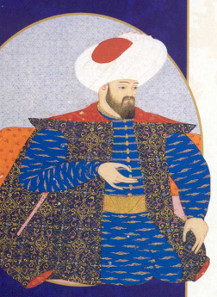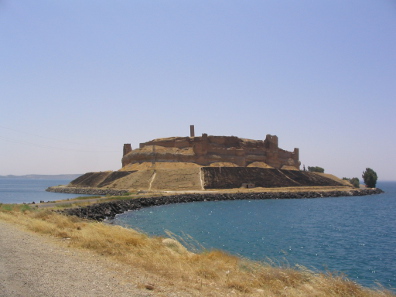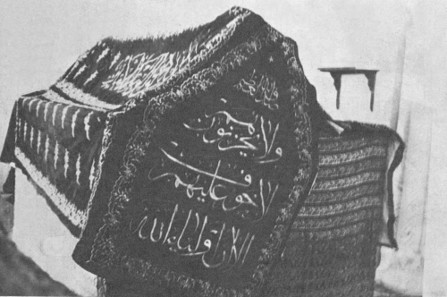by Björn Schöpe
May 7, 2015 – While the IS movement destroys with impunity many cultural objects and monuments, Turkey has demonstrated how it intends to protect objects considered to be of political relevance. Turkish soldiers just transferred the remainings of the ‘ancestor of the Turkish Republic’ from Syria to Turkey to safeguard them from the islamists.
Osman I, Ottoman miniature painting (1579/80).
Osman I is considered founder of the Ottoman Empire that means the precursor state of Turkey. When his grandfather Suleyman Shah drowned in the river Euphrates in 1236, he was buried nearby. For centuries this piece of land was part of the Ottoman Empire. Troubles arose after the Great War with the gigantic empire decomposing and the tomb of Suleyman Shah suddenly being on French controlled Syrian territory. In the Treaty of Ankara in 1921 Turkey ensured that the tomb was acknowledged as Turkish property. Ever since Turkish soldiers would stand guard and hoist their own colours.
The previous location Qal’at Ja’bar on a Euphrates isle is today in the middle of the Lake Assad created in 1974. Photograph: Wikicommons / http://creativecommons.org/licenses/by-sa/3.0/deed.en
At that time the tomb was situated on an isle in the river Euphrates. In the 1970s however, it was endangered by the construction of a river dam that would flood the complete area.
The new location nearby the city of Sarrin. Photograph: Céline Rayne / http://creativecommons.org/licenses/by-sa/4.0
That was the reason why, in 1973, Turkey decided to transfer the tomb into a mausoleum near the Turkish frontier. Since fighting started in Syria in 2011 the political relevance of this tomb has increased. As a matter of fact the position is that the tomb belongs to Turkey. Turkey, though, has always held the opinion that the whole area where the tomb is located were an exclave and therefore Turkish sovereign territory. They even required visitors to show their passports.
For years the IS has provoked Turkey by threatening to attack the mausoleum if Turkey did not evacuate it. Turkey’s President replied sharply that such an action would be considered an attack on Turkey – and hence an attack on the defense alliance NATO.
Reportedly since September 2014 more than 1,100 IS fighters had been besieging the mausoleum where some dozens of Turkish soldiers held the ground. In the night to February 22, 2015 Turkey started the operation ‘Shah Euphrates’: some 100 tanks and armoured vehicles and about 500 soldiers crossed the border to Syria with the support of drones and surveillance aircraft. The tomb and the guards where evacuated while the marble mausoleum was blown up to avoid that the terrorists might employ it as operation base.
This was how the coffin looked like in 1921.
Now Suleyman’s remains are waiting for their new placing – again in Syria as Turkish representatives already stated.
You can find an article on the topic here.
On the operation the BBC reported extensively here …
… and here.
And the Wikipedia article gives a full account of the history of Suleyman Shah’s tomb.








